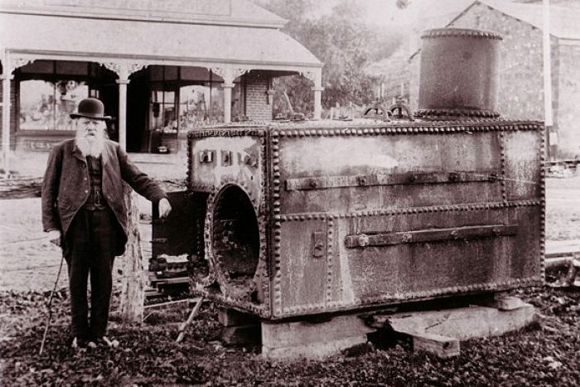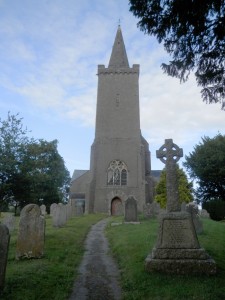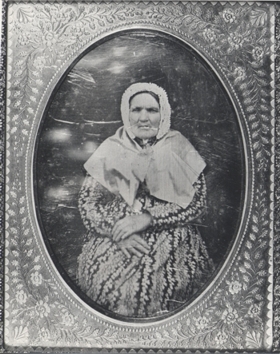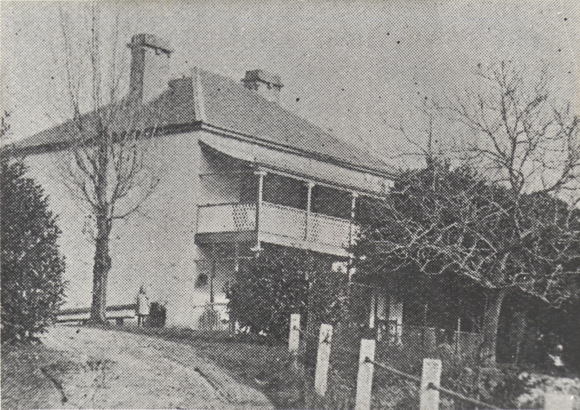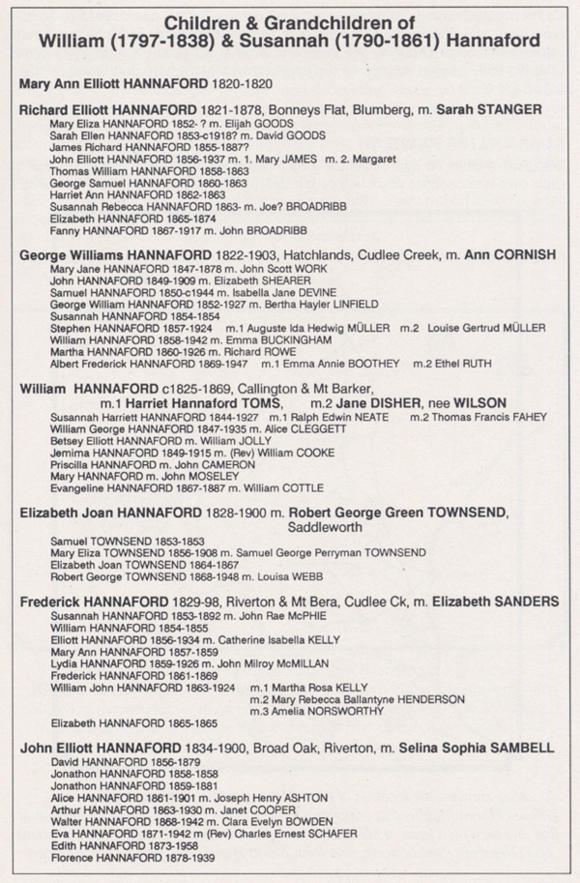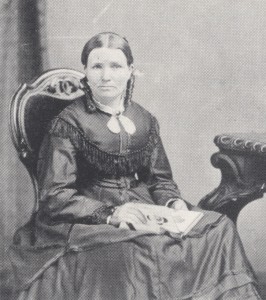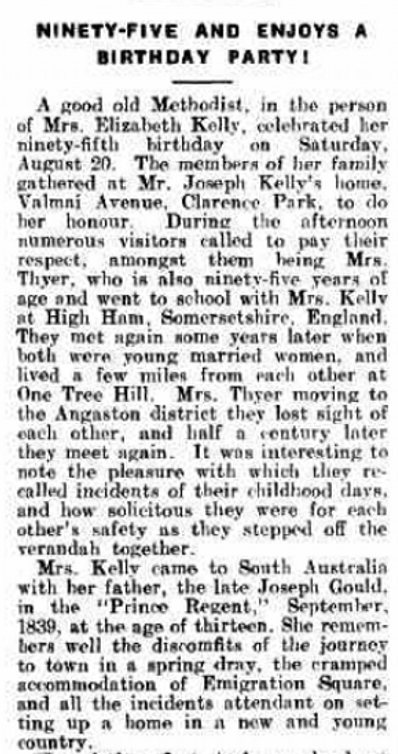Genealogy Close Calls
I was inspired to write this post as a result of reading Heather Rojo’s blog, Nutfield Genealogy, when wrote about her “Top Ten Genealogy Close Calls“.
The title alone intrigued me, as I wasn’t quite sure what she meant by ‘genealogy close call’. But she explains it well:
“What’s a “Genealogy Close Call”? It happens when I research an ancestor and realize that if fate didn’t intervene I wouldn’t be here today. Some of our ancestors narrowly escaped disasters, only to live on and produce a descendant that led to YOU. “
So that got me thinking. Did I have any “genealogy close calls”. My initial thoughts were no, but as the day progressed I remembered the following incidents:
MY GENEALOGY CLOSE CALLS
WILLIAM KENNARD ELPHICK (c1815-1869) – Survived the voyage
and wife SUSANNA ELPHICK (nee ELLIOT) (c1812-1899)
William and his wife Susanna married in London in November 1838, and then immediately boarded the ‘Plantar’ ship to start a new life in Australia. The journey which on average takes about four months, took almost six months partly due to the captain’s incompetence – missing a port where they were meant to collect supplies, and having to stop elsewhere as a result, together with other misadventures such which included much of the crew being lost, as were some passengers and most of the livestock. Eventually a new crew was acquired and the journey continued. For more on their story click here. The Elphick family settled in Adelaide, and had numerous children. The Elphick’s are Mr Lonetester’s 3x great grandparents. While not everyone survived this journey, they did, and if they hadn’t he wouldn’t have be here.
OTTO RAFAEL WINTER (1880-1961) – WW1 injuries
Otto Winter was born in Finland and spent 7 years sailing the world on a merchant sailing ship. I’m sure if I had detailed of every voyage there would be ‘close call’ stories there, but I don’t, so I won’t make assumptions. After having jumped ship in Australia, he chose to get naturalised and in 1916 he signed up for the Australian Army in WW1 and was sent off to Belgium. During his three years in the AIF he was wounded several times, including being shot in the stomach and poisoned with mustard gas while tunnelling at Ypres. Despite this, he survived and made it home to his young wife and baby boy. Had he not survived my grandma would not have been born. For more on Otto Winter click here.
————————
GENEALOGY CLOSE CALLS, BUT NOT CLOSE ENOUGH
ISAAC RICHARDSON (1804-1873) – sentenced to death
A labourer in Kent, Isaac Richardson together with his bother Simeon, were rioting to stand up for their rights during the Industrial Revolution. Sentenced to death, the local townspeople petitioned to save their life and both were then sentenced to transported to Van Diemen’s Land for life instead. Isaac’s wife Matilda (nee Bonner) and the two children Edward and Esther were given assisted passage in 1837-38. Isaac was granted a conditional pardon in 1842. Isaac and Matilda had a total of 9 children, and continued to live in Tasmania. Isaac’s first born child, Edward was my 3x great grandpa). As Edward was already born before Isaac was transported, this doesn’t count as a ‘close call’ for me, but for descendants of the 7 children that were born later it certainly would. You can read more about Issac Richardson here.
WILLIAM RICHARD RANDELL (1824-1911) – near explosion
William Richard Randell is known as the father of paddlesteamers on the River Murray. He emigrated with his parents from Devon, England in 1837 and initially they bred cattle and drove them along the land along the Murray River, in South Australia and later setup flour mills in the Adelaide Hills. Despite having no previous experience in navigation or having ever seen a steamboat, W.R. Randell became obsessed with building a paddlesteamer to transport supplies up and down the river. And by 1853 the “Mary Ann” which he built became the first paddlesteamer in South Australia. The boiler, a box shape, and made of lead riveted together was said to have “needed chains wrapped around the middle. Even then when proceeding at maximum speed the sides and top were observed to swell in and out like a concertina”. And while it didn’t explode, but it seems like it wasn’t far from it. William Richard Randell is a half-brother to my 2x great grandpa … so he’s not a direct relative. But had he not survived his paddlesteaming days, it certainly would affected his direct line.
GEORGE PHILLIPS (1865-1941) – nearly drowned
There’s a story that’s been handed down the generations in my family about George Phillips. George Phillips and his wife Mary Ann (nee Kemp), along with their baby boy, also George, emigrated from England to South Australia in 1865 onboard the “Adamant”. The story goes that a fellow female passenger was holding baby George, when Mary Ann had a bad feeling or premonition, so she collected him from the lady, and shortly afterwards that poor lady fell overboard. I don’t know the validity of the story, except that there was a lady who drowned on the voyage out mentioned in the surgeon’s journals. So it is a possibility. And as baby George survived, he counts as a genealogy close call, although not for me, as he’s a brother to my great great grandpa, not my direct line.
————————
While I don’t have many ‘close calls’ in this list. Ok technically only two, this just means that I have more research to do. More digging to find the stories.
Just think of all the possibilities there are, past and present: car accidents, horse and cart accidents, farm accidents, mining accidents, fires in the house, other occupational accidents, childbirth, fell down steps, numerous diseases and ailments, natural disasters (fires, floods, famine, tornado, cyclone, hurricane), major sporting injuries, a close encounter with a wild animal, or was your ancestor known for getting in fights? The list is endless …
Now I’m off to see what else I can find …
My First Hannaford Family in Australia
For Australia Day this year I decided to write about the Hannafords, who are one of my immigrating families. Or more specifically I should say, about Susannah Hannaford (nee Elliott), who is truly the matriarch of the family, and her children.
I admit I am in awe of Susannah, in some ways anyway. She was a widow by age 48, not an easy thing for anyone, but then to pack up all of your belongings and move to the other side of the world, to a colony that had only been founded a few years before, with her six children, leaving her family, friends and whole life behind, to start again from scratch. I can’t even begin to think of what that would be like or how she managed it. But she survived. So did her children, and now her descendants number the thousands.
But let’s go back a little bit first.
Back in Devon …
Susannah Elliott was born in 1790 in the market town of Totnes, in Devon, England. Meanwhile the Hannaford family (the ones I’m writing about anyway), grew up just four miles away in the little town of Rattery. I mention that as the Hannaford name in Devon is much like Smith or Brown everywhere else. Hannafords are everywhere!
When Susannah was 30 years old, she married William Hannaford (one from the neighbouring parish in Rattery), and who was actually a few years younger than her. Sadly William died at age 42, leaving Susannah with six children ranging in age from 17 down to 6.
Devon at that time (actually probably England at that time) had limited employment opportunities, and with high taxes (land tax and window tax for instance), it would seem that emigrating to a new land offered better prospects than staying in Devon.
The Voyage and Arrival …
So in 1840 Susannah and her clan together with 164 other passengers, boarded the “Brightman”, which was a three-masted barque which sailed from London, to Plymouth, and on to South Australia, making a quick voyage in just 106 days. Again, I can’t envisage what that would have been like. The closest I’ve been to this is a large cruise ship for 21 days which doesn’t even vaguely compare in any way whatsoever!
The Verco’s were also aboard the Brightman, and the following is an extract from the “Early Recollections of Sir Joseph Verco” which was written around 1930.
“The Brightman was a dry and comfortable ship. The bunks were arranged athwart ships along the sides of the vessel leaving a passage down the middle of the ‘tween decks. If in bed the passengers had to shift pillows from one end of the bunk to the other else he would be lying with his head down and his feet at a much higher level. Captain Nockells was a religious man conducting regular Sunday services, and he never failed to close with Psalm 139 verses 7-12. He would then invoke the blessing of God on the ship and those within, followed by the benediction. The Brightman made good passage of only 106 days. Keeping as much to the eastward as possible on the way south to avoid the dreaded Cap San Roque and its leeward currents. They sailed close round the Cape of Good Hope, then well to the north … and anchored in Holdfast Bay on 10 December 1840.
From the time of anchoring to the time of departure from the ship, there was a delay of seven days for some passengers. Boats transported the passengers and their luggage to land. Many floatable articles, such as wooden framed houses, manufactured and packed in England for immediate erection on landing in Australia, were simply tossed overboard and then tided to shire. All this took time and meant a long and tedious wait onboard for passengers.
When not concerned with the activity going on around them, those onboard found themselves preoccupied with thoughts of what awaited them beyond the shores amid the dense forest of trees and scrub … As it was they could see hundreds of natives moving along the shoreline. More than once they had been startled by the noise of a corroboree, one of which had been followed by fierce fighting resulting in many naked warriors being speared to death. Even at a distance it was somewhat frightening, but still more unnerving had been the screaming and yelling of the lubras as they mourned their dead.”
From the ship at Holdfast Bay (now Glenelg) it was a case of making the trip to Emigration Square in Adelaide, approximately 12 kilometers away, and with no roads. For many it was a case of walking the trip while for others they travelled by bullock dray. Emigration Square, situated on the Parklands, just west of Hindley Street contained 30-40 wooden huts in 1839-40, which were made for newly arrived emigrants to have a place to stay until they moved on.
Settling in South Australia …
The records show that the first house Susannah bought in South Australia was a 2 acre property at Unley in 1841. This was a small cottage and she established a mini farm on the land. By this time her two oldest two sons, Richard and George, went off cattle herding for the South Australian Company. And no doubt it was during one their travels that they heard of “fertile land with springs and running water 25 miles from Adelaide”. So George and his friend from the ship, James Verco, set out to find this land, and found it at Cudlee Creek, in the Adelaide Hills.
George was impressed with it, so much so that Susannah immediately bought land there, and in 1849 had a cottage built from stone quarried on the property. They named this property “Hatchlands” after the family property in Devon “Hatchland”. And this was the start of the Hannaford’s at Cudlee Creek. And today (six generations and 168 years later), they are still in the region.
As her family grew up and got their own properties, you will find descendants of Susannah’s living at Bonney’s Flat, Birdwood (Blumberg), Riverton, Saddleworth and of course Cudlee Creek (all in South Australia). And some of the property names associated with the family are ‘Broad Oak’, ‘Mount Bera’, ‘Riverside’, ‘Dingo Vale’, ‘Wattle Vale’, ‘The Briars’ and ‘Greenhills’.
The Hannaford’s have been heavily involved in the Fruitgrowers and Agricultural Associations for many years, and were known for their top class and prize winning apples. Some even winning international prizes. And I’m proud to say that today there are still family members running these generations-old apple orchards.
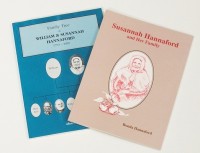 Of course Susannah and her family’s story doesn’t stop there. There are many achievements and noteworthy things from numerous descendants, but it’s too much for this post. But for anyone that does want more info on the family, I suggest getting a copy of both the following books, as they contain plenty of detail:
Of course Susannah and her family’s story doesn’t stop there. There are many achievements and noteworthy things from numerous descendants, but it’s too much for this post. But for anyone that does want more info on the family, I suggest getting a copy of both the following books, as they contain plenty of detail:
– Susannah Hannaford and her Family
– The Family Tree of William and Susannah Hannaford 1790-1990
This chart below shows Susannah and William Hannaford, their seven children (the first one died in infancy), together with their grandchildren. Seeing this you’ll understand WHY there are so many Hannaford’s around now.
Susannah Hannaford (1790-1861)
Truly a pioneer
And the matriarch of an incredible clan
95, and What a Birthday it Was!!!
Today’s Trove Tuesday post doesn’t really require much text from me, as the article is self-explanatory.
The article below comes from the Australian Christian Commonwealth newspaper, and is dated Friday 2 September 1921. This article is about my 3x great grandma, Elizabeth Kelly (nee Gould) on her 95th birthday party.
NINETY-FIVE AND ENJOYS A BIRTHDAY PARTY!
A good old Methodist, in the person of Mrs. Elizabeth Kelly, celebrated her ninety-fifth birthday on Saturday, August 20. The members of her family gathered at Mr. Joseph Kelly’s home, Valmai Avenue, Clarence Park, to do her honour. During the afternoon numerous visitors called to pay their respect, amongst them being Mrs. Thyer, who is also ninety-five years of age and went to school with Mrs. Kelly at High Ham, Somersetshire, England. They met again some years later when both were young married women, and lived a few miles from each other at One Tree Hill. Mrs. Thyer moving to the Angaston district they lost sight of each other, and half a century later they meet again. It was interesting to note the pleasure with which they recalled incidents of their childhood days, and how solicitous they were for each other’s safety as they stepped off the verandah together.
Mrs. Kelly came to South Australia, with her father, the late Joseph Gould, in the “Prince Regent,” September; 1839, at the age of thirteen. She remembers well the discomfits of the journey to town in a spring dray, the cramped accommodation of Emigration Square, and all the incidents attendant on setting up a home in a new and young country.
Her father first took up land at Brown Hill Creek. Mr. Sleep, after whom Sleep’s Hill is named, used to conduct services in his house, and Mrs. Kelly attended them. She remembers hearing the late D. J. Draper preach his farewell sermon in the chapel in Gawler Place. Later they .moved to Cudlee Creek, and she sometimes walked nine miles to church. (Attention! young people, please).
She was married to Mr. William Kelly in Trinity Church by Dean Farrell in 1846, and they settled at One Tree Hill, where Mr. Kelly was a great help to the struggling Methodist cause, and assisted with the building of the church, under the leadership of the Rev. Joseph Lloyd. Mr. Kelly died in the year 1891.
Mrs. Kelly had eleven children, fifty grandchildren and seventy great-grandchildren. Mrs. Kelly is the proud possessor of a roll of honour in the form of a photographic group of thirteen
grandchildren who fought in the great war (three of whom did not return). The surviving members of the family are Mr. Joseph Kelly, late of Maitland, now of Clarence Park; Mrs. E. Linklater, Wilmington; Mrs. D. Harrington, Prospect ; Mrs. A. Adams, Smithfield; Mr. J. Gould Kelly, Riverton; Mrs. H. H. Blackham, One Tree Hill; Mr. E. A. Kelly, “Yelki,” Smithfield, and Mrs. E. H. Rhodes, Gilberton. Mrs. Kelly’s descendants are favourably known in many of our country circuits.
You can find the full original article on Trove here.
And just for reference, Elizabeth Kelly (nee Gould) lived on for another 3 years!
For more on the Gould family, have a read of this article on the Tea Tree Gully Historical Society website.
Homeopathy and the Treasures Between the Pages!
Homeopathy: “The study of natural therapy which stimulates the body’s immune system to restore health”. It was something that my great grandpa, J.B. Randell taught himself.
Ever looked through an old book and found something slotted in the pages in between? I have. Regularly. I’ve mentioned before that my mum’s side of the family weren’t one’s to throw things out. Putting it nicely “hoarders”, and for that I’m eternally grateful, as it has meant that we have SO MANY family heirlooms dating back generations, it’s truly amazing.
One thing that seems to have been a ‘thing’ that’s been passed down through the generations of Randell’s, was the habit of putting things in the middle of books. I’ve always known my grandma to do that, and have often discovered random newspaper cuttings, birthday cards, flattened Easter egg wrappers and more in the pages of books of hers. Now this book of her fathers, John Beavis “JB” Randell (to my surprise) has even more bits filed in between the pages.
I found a total of 25 items in amongst the pages of the book, and I have scanned each one of them, and that’s what I wanted to share with you today. Some are interesting, others not. But from there there are clues which could lead to further research …
[espro-slider id=9875]
As you will see there’s a collection of all sorts, from receipts, to newspaper cuttings, to bible verses, envelopes, hair, leaves, a bookmark and other printed items. I’ve noted them below, as the caption on the slider was so tiny it wasn’t readable.
1. Gumeracha Town Hall Concert, 9 August 1924
2. Receipt from Norsworthy’s store, Gumeracha, dated 9 September 1924
3. Dried leaves
4. Hair or fur
5. More dried leaves
6. front of homeopathic remedies brochure
7. advert for Nurse Grace’s ointment
8. Receipt of the sale of rabbit skins by Restyn Randell, dated 2 May 1922
9a. Front of bible verse card for Restyn Randell
9b. Back of bible verse card for Restyn Randell
10. advert for Dr Ricords Interesting Book for Men
11. “Forget Me Not” bookmark
12. Coats crochet cotton wrapper
13a. Front of Pulteney Street parking station ticket
13b. Back of Pulteney Street parking station ticket
14. British and Foreign Bible Society, Gumeracha, 15 September 1918
15. Journal of Department of Agricultre, Victoria addressed to J.B. Randell
16. Good citizenship leaftet, dated 11 February 1925
17. Envelope addressed to J.B. Randell, Kenton Park, Gumeracha
18. Birks Pharmacy letter
19. Handwritten notes
20. Postage paid envelope
21. ‘By Grace Ye Are Saved’ card
22. Readers Digest letter to D.A. Randell
23. Tag with list written on it
24a. front of Fruitgrowers Association of Gumeracha envelope
24b. back of Fruitegrowers Association of Gumeracha envelope
25. Receipt from Norsworthy’s Store, Gumeracha, for J.B. Randell dated November 1942
Now excuse me while I head off to the bookshelf, and start paging through more old books, to see what else I can find.

